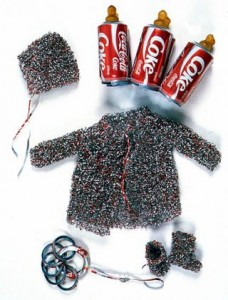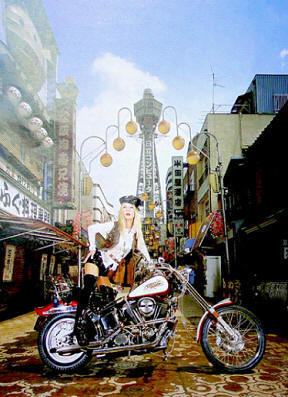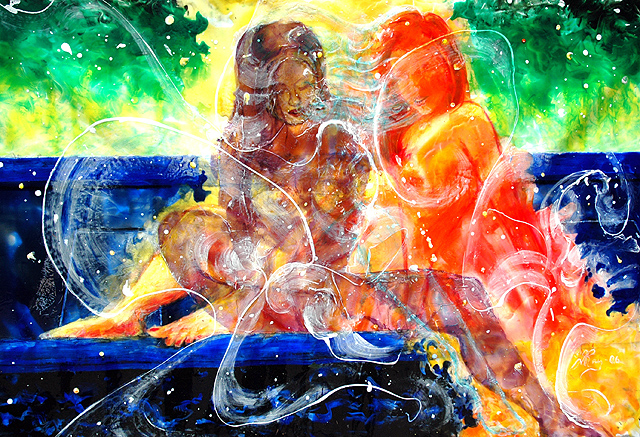Not always Postmodernism can be easily distinguished from Modernism. Modernism separates “fine art” and “low art”, or “high culture” and “mass culture”, while Postmodernism tends to compare and mix non-traditional media and images (Harris 2001). Postmodern artists “share a healthy suspicion of all traditional truth claims and value standards, all hierarchical authority and institutions” (Kleiner 2008, p. 987). Postmodern art can be defined through several characteristics, which are most common for all postmodern artworks. The characteristics might include such qualities as expansion, complexity, simplification, performance art, response to surroundings, appropriation, responding to context, appropriation, juxtaposition, collage, politics, feminism, installation art, site-specific, non-traditional materials, mixing images and media, mundane elements, kitsch (Postmodernism Characteristics 2012).
An efficient way to define and characterize postmodern art is to have a close look at some postmodern artists and examine their works. Let us consider three different Postmodernists and make an analysis of some of their works. They are Australian artistic photographer and sculptor Fiona Margaret Hall, American Post-Modern Expressionism artist Donray and Japanese appropriation artist Yasumasa Morimura.
The main themes of Fiona Hall’s art are society and culture. It also reflects the problem of human influences upon nature and the whole world. Fiona’s ideas and way of thinking are usually multi-faceted. Her works are often complex and highly detailed.

For example, her work Medicine Bundle for the non-born Child is made from recycled Coca-Cola cans and knitting. Coca leaves from South America and cola nuts from Africa are used in the world’s most popular soft drink, which is a symbol of capitalism and globalization. It is also a global marker of modernity. The work shows the misappropriation of knowledge from the Third World countries, as well as the theme of the desire for consumer goods (Guthrie 2010). Fiona wants viewers to become concerned about their children’s future. She combines a very popular brand and child’s clothes made of it. Hall makes a visible contrast with the object, creating the underlying emotional mood. This also helps to deliver the message to the viewer. Contrast is one of the main elements. It can be seen in the materials, which is the objects of these work made of. The cold and sharp metal stripes can be hardly combined with something that is related to a child. At the first glance, it looks like knitted wool, but then viewers realize that it is something sharp, cutting, and unappropriated for a child’s clothes. This work is unified by repeated use of colors, shapes and items.
Yasumasa Morimura often inserts his face or body into historical artists’ images. By inserting himself into the different works of historical great artists, he shows his respect to them, but it can be viewed as “a cultural statement on many (still) taboo categories of debate – masculinity, femininity, essentialism and the appropriation of historical works” (Yasumasa Morimura 2009). His work includes the painstaking process. He spends a lot of time “re-creating an environment (sometimes to perfect scale)” and “focuses a great deal in sourcing costumes, makeup and props” (Yasumasa Morimura 2009). Sometimes Yasumasa includes kitsch in his arts. He also tends to include pop icons in some of them. “This reference to popular culture from both the East and West signifies the transition of technological advances in art practices as well as exploring the value, or de-valuing, of art history” (Yasumasa Morimura 2009). Many features of contemporary visual art are presented in his works, such as “sense of cultural disconnection, experimentation with process, his tireless pursuit for (in)perfection” (Yasumasa Morimura 2009). All of these features interconnect with the self-determination through his works in an almost comical manner. The major themes in Morimura’s works are related to the exploration of cultural identities, intercultural exchanges, as well as gender identity. These themes are mainly considered in the context of cultural communication and globalization.

One of his most famous work is After Brigitte Bardot 2. It is a part of Self-portrait series. Actress Brigitte Bardot is the main subject in this work. She is dressed in shiny black leather shorts and boots, sitting on a Harley Davidson motorcycle. These all are stereotypical features of American pop culture. It is a parody. At the same time, the image is pulled out of a natural context. The archetype of American popular culture is placed on the downtown street of Osaka. Her face is replaced by that of the Morimura. Thus, Morimura shows that “identity can be defined in terms of national icons,” such as the Bardots and Harley Davidsons of the USA and the typical downtown street in Japan (Roca 2009, p. 2). However, Morimura’s Bardot possesses “a more complex, hybrid identity, augmented by the fact that she is played by an Asian male, while being quintessentially Western” (Roca 2009, p. 2). Consequently, Yasumasa shows that “identity should be perceived as a composite of multiple identities”, rather than a single one, in the current context of globalization (Roca 2009, p. 2).
Donray is a Post-Modern Expressionism artist. His style also includes elements of Surrealism, Futurism and Fauvism. His works are known for metaphorical imagery. They are exploring lively nature and life. In addition, they often represent a longing for spiritual fulfillment. His major subjects are objects and landscapes in motion. He is well-known for his innovative technique. Donray’s works include the acrylic and acrylic-on-acrylic method he had discovered. He was using various media from paper and canvas to charcoal, conte crayon and Masonite. Movements including Baroque, Romanticism and German Expressionism also inspired Donray. Donald Kuspit describes his works as “a verve, an energy, a dynamic surging gesture, violent movement, an overall vividness and vitality that places Donray’s paintings among the most interesting of what might be called the post-modern expressionist painting” (Kuspit, Bass & Luytens 2008, n.p.).
His work Woman in a Boat is powerful, energetic and dreamlike. The use of color is bright and contrasting. The imagery is emotional and somehow double-sided. Boat and water are usually represent something silent, calm, gradual, etc. But it is highly contrasted with bright yellow and green colors. The work called Woman in a Boat, though it is almost clearly visible two images. This can be interpreted as if the first darker image of a woman is her physical form, while the bright red image is her spirit, inner essence. Maybe the artist wanted to show that every woman has a fire inside. The central image of the woman is dull and sad, while her fire form is alive and forceful.

In contrast to Modernism, Postmodernism evades from the firm definition. Postmodernism can be defined through the rejection of modernist ideals, but it is not that simple. Despite that Donray, Yasumasa Morimura and Fiona Hall are postmodern artists, their works are completely different and it is hard to find common traits among them. However, these three well-known Postmodernists made a great contribution to this concept.
References
Guthrie, S 2010, Artist of Substance: Fiona Hall, Web.
Harris, J 2001, The New Art History: A Critical Introduction, Routledge, London.
Kleiner, F S 2008, Gardner’s Art through the Ages: A Global History, Ph.D., Columbia University, New York City.
Kuspit, D, Bass, R, Luytens, D 2008, ‘Donray, A Cross-Section’, Exhibition Catalogue, One Man Show, Arlington Museum of Art, n.p.
Postmodernism Characteristics 2012, Web.
Roca, R 2009, ‘The Exploration of Identity through Self-Portraiture’, Niram Art Magazine, p. 2.
Yasumasa Morimura2009, Web.